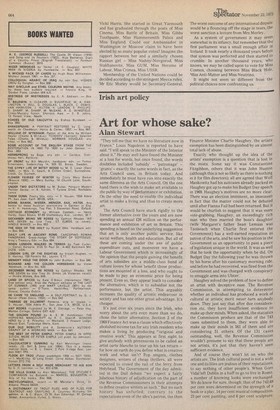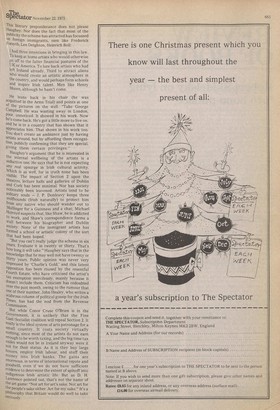Irish art policy
Art for whose sake?
Alan Stewart
"They tell me that we have no literature now in France," Louis Napoleon is reported to have said, "I will speak to the Minister of the Interior about it." He may well have found the Minister at a loss for words, but once found, the words doubtless included 'subsidy' 'patronage' 'grants'exactly the same words in fact, as the Arts Council uses, in Britain today. And immediately he must have run into exactly the same dilemma as the Arts Council. On the one hand there is the wish to make art available to the public by way of performance or exhibition. On the other the need to enable the individual artist to make a living and thus to create more art.
The Arts Council have stuck rigidly to the former alternative over the years and are now spending an annual £26 million on the performance and exhibition of art in Britain. This spending is based on the underlying suggestion that art is only another public service, like social welfare, health and education. But all of these are coming under the axe of public expenditure cuts, and moreover we have a Labour Government which is increasingly of the opinion that the people gaining the benefit of arts subsidies are a middle-class band of culture lovers for whose benefit these productions are mounted at a loss, and who ought to be made to pay an economic price for being present. Even so, they appear loath to consider the alternative, which is to subsidise not the performance, but the artist. This arguably increases the quality of artistic endeavour in society and has one other great advantage. It's cheaper.
It's just over six years since the Irish, who worry about the arts even more than we do, chose the latter alternative. Section 2 of the 1969 Finance Act was a clause which effectively abolished income tax for any Irish resident who makes a living by producing '"original and creative work" This appears at first sight to give anybody with pretensions to be called an artist carte blanche to tear up his tax return for how on earth do you define what is creative work and what isn't? Pop singers, clothes designers, writers of cheap thrillers, all were expected to crowd the rail of the ferry from Holyhead. The Government of the day admitted in the Dail debate "we expect a fairly hilarious history of adjudication on the part of the Revenue Commissioners in their attempts to define creative Writers as such." But no such history has unfurled; contrary to the expectations even of the idea's patron, the then
Finance Minister Charlie Haughey, the artists exemption has been distinguished by an almost total lack of abuse.
Exactly who thought up the idea of the artists' exemption is a question that is lost in the mists. Some say it was Constantine Fitzgibbon, others that it was John Huston (although this is not so likely as there is nothing in it for film directors): all are agreed that Wolf Mankowitz had his suitcases already packed as Haughey got up to make his Budget Day speech in 1969. Haughey's motives are no more clear. There was an election imminent, so imminent in fact that the matter could not be debated until after Fianna Fail had been returned. But it would be churlish to suggest that it was mere vote-grabbing. Haughey, an exceedingly rich man who then married the boss's daughter (wife Margaret's father Sean Lemass was Taoiseach when Charlie first entered the Government) has a well-earned reputation as patron of the arts, and he saw his position in the Government as an opportunity to pass a piece of legislation unique in the world. It was as well that he took the opportunity when he did. On Budget Day the following year he was thrown by his horse after his customary morning ride, and before he had recovered, was fired from the Government and was charged with conspiracy to smuggle arms into Ulster.
Haughey solved the problem of how to define an artist with deceptive ease. The Revenue Commission, in attempting to determine whether an individual has produced a work of cultural or artistic merit never turn anybody down. They just say that after due consideration etc, they have insufficient evidence to make up their minds. When asked, the statistics the Commission produce are that of the 743 cases submitted to them, they were able to make up their minds in 561 of them and are considering 51 others. Of the 131 cases outstanding, well, the Revenue Commission wouldn't presume to say that these people are not artists, it's just 'that they haven't seen sufficient evidence.
And of course they won't let on who the artists are. The Irish cultural pond is not a wide one and its lilies are jealous of their reputations. to say nothing of other people's. When Gore Vidal left Dublin in a huff to go to live in Rome, a number of knowing looks were exchanged. We do know for sure, though, that of the 743,68 per cent were determined on the strength of a book or a play, 14 per cent musical composition, 23 per cent painting, and 6 per cent sculpture.
This literary preponderance does not please Haughey. Nor does the fact that most of the Publicity the scheme has attracted has focussed on foreign immigrants, men like Frederick Forsyth, Len Deighton, Heinrich Boll: I had three intentions in bringing in this law. To keep at home artists who would otherwise go off to the fatter financial pastures of the UK or America. To lure back artists who had left Ireland already. Third to attract aliens , Who would create an artistic atmosphere in the country, and would perhaps form schools and inspire Irish talent. Men like Henry Moore, although he hasn't come.
He leans back in his chair (he was acquitted in the Arms Trial) and points at one
of the pictures on the wall. "Take George Campbell. He was wasting away in London, Poor, unnoticed. It showed in his work. Now he's come back. He's got a little more to live on,
and he is in a country that has shown that it appreciates him. That shows in his work too.
You don't create an ambiance just by having artists around, but by affording them recognition, publicly confirming that they are special, giving them certain privileges." Haughey's argument that he is interested in the internal wellbeing of the artists is a seductive one. He says that he is not expecting any real upsurge in Irish cultural activity. Which is as well, far in truth none has been visible. The impact of Section 2 upon the theatres, lecture halls and galleries of Dublin and Cork has been minimal. Nor has society noticeably been leavened. Artists tend to be solitary souls — J. P. Donleavy keeps three Wolfhounds (Irish naturally) to protect him from any native who should wander out to Mullinger for a Guinness and a chat; Michael floiroyd suspects that, like Shaw, he is addicted to work, and Shaw's correspondence forms a Wall between his biographer and Dublin society. None of the immigrant artists has formed a school or artistic colony of the sort that had been hoped. "But you can't really judge the scheme in six Years. Evaluate it in twenty or thirty. That's how long it will take." Haughey says that in the knowledge that he may well not have twenty or thirty years. Public opinion was never ' very impressed by 'Charlie's Gold,' and this latent oPposition has been roused by the resentful Fourth Estate, who have criticised the artist's tax exemption mercilessly, mainly because it doesn't include them. Criticism has redoubled over the past month, owing to the rumour that one of their number, John Healey, who writes a scabrous column of political gossip for the Irish Times, has had the nod from the Revenue Commission. But while Conor Cruse O'Brien is in the Government, it is unlikely that the Fine Gael/Socialist coalition will repeal Section 2. It really is the ideal system of arts patronage for a small country. It costs society virtually nothing, since most of the artists do not earn enough to be worth taxing, and the big time tax exiles would not be in Ireland anyway were it not for their status. As it is they buy large houses, employ Irish labour, and stuff their money into Irish banks. The gains are enormous, in terms of international repute and goodwill; even if we do not have sufficient evidence to determine the extent of spinoff into Indigenous Irish artistic life. But as D. H. Lawrence pointed out, that's not the name of the art game: "Not art for art's sake. Not art for the people's sake either. Art for my sake." It's a Philosophy that. Britain would do well to take seriously.

































 Previous page
Previous page